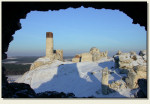Search
Alphabetical index
a palace in Wilanów
Babice
Bagieniec
Baranów Sandomierski
Barciany
Bardo
Barwałd Górny
Baszków
Bąkowa Góra
Besiekiery
Będzin
Białaczów
Białawoda
Biecz
Biedrzychowice
Bielsko-Biała
Bierutów
Bobolice (Lower Silesian province)
Bobolice (Silesia Province)
Bobrowniki
Bobrów
Bobrów Castle
Bochotnica
Bodzentyn
Bolczów Castle
Bolesławiec (Łódz Province)
Bolków
Bolmin
Borów Polski
Borysławice Zamkowe
Borzygniew
Bożków
Brok
Bronów
Brzeg
Bychawa
Byczyna
Bydlin
Bytów
Chełmo
Chęciny
Chlewiska
Chobienia
Chocianowiec
Chocianów
Chocz
Chojnik Castle
Chojnów
Chudów
Chwarszczany
Ciechanowice
Ciechanów
Ciepłowody
Cieszków
Cieszyn
Cisy Castle (of the Cis family)
Czarny Bór
Czchów
Czemierniki
Czerna
Czernina
Czersk
Częstochowa
Człuchów
Czoch Castle
Czorsztyn
Czyżów Szlachecki
Decjusz’s Villa
Dęblin
Dębno
Dobczyce
Dobra
Domanice
Dunajec Castle
Dzierżoniów
Dzietrzychowice
Dziewin
Frombork
Frydman
Giebułtów
Głogów
Głogówek
Gniew
Gniewoszów
Gola
Gola Dzierżoniowska
Golczewo
Golub-Dobrzyń
Gołuchów
Gorzanów
Gościszów
Góra
Górka Castle
Grodno Castle
Grodziec (Lower Silesia Province)
Grodziec (Silesian Province)
Grodziec Castle
Gryf Castle
Gryfów Śląski
Grzędy (Wojaczów)
Grzmiąca
Henry's Castle
Iłża
Janowice Wielkie
Janowiec
Jawor
Jelcz-Laskowice
Jelenia Góra
Jelenia Góra-Sobieszów
Jeżów (Wilczyska)
Jędrzychów
Kamieniec
Kamieniec Ząbkowicki
Kamienna Góra
Karpień Castle
Karpniki
Karpno (Lądek Zdrój)
Kazimierz Dolny
Kąty Wrocławskie
Kętrzyn
Kliczków
Kłaczyna
Kłodzko
Koło
Konradów Castle
Kozienice
Kozłówka
Koźmin Wielkopolski
Kożuchów
Kórnik
Kraków
Kraków
Kraków – Branice
Krasków
Krąg
Krobielowice
Krosno Odrzańskie
Krupe
Krzyżtopór Castle
Książ Castle
Książ Wielki
Kurozwęki
Kwidzyn
Lanckorona
Legnica
Lidzbark Warmiński
Lipa
Lipowiec Castle
Liw
Lubin
Lublin
Lubliniec
Lwówek Śląski
Łęczyca
Łodygowice
Łupki (Wleński Gródek)
Maciejowa (Jelenia Góra)
Malbork
Melsztyn
Melsztyn Castle
Mieroszów
Międzygórz
Międzylesie
Międzyrzecz
Mirów
Mirów Castle
Modła
Mokrsko Górne
Myślenice
Nawojowa
Nidzica
Nieborów
Niedzica
Niesytno Castle
Nowy Dwór Castle
Nowy Jasiniec
Nowy Sącz
Nowy Wiśnicz
Ogrodzieniec Castle
Ojców
Oleśnica
Oleśnica Mała
Olsztyn (Silesian Province)
Olsztyn (Warmia-Masuria Province)
Oława
Opole
Oporów
Ostróda
Ostrzeszów
Oświęcim
Otmuchów
Owiesno
Panków
Papowo Biskupie
Pastuchów
Pęzino
Pieskowa Skała
Pieszyce (Rościszów)
Piotrowice Świdnickie
Płakowice
Płonina
Podskale Castle
Podzamcze
Podzamcze Piekoszowskie
Proszówka
Przezmark
Przymiłowice Castle
Pszczyna
Rabsztyn
Raciążek
Radosno Castle
Radzyń Chełmiński
Rakowice Wielkie 1
Rakowice Wielkie 2
Reszel
Rogowiec Castle
Rogów Sobócki
Rudnica
Rudno
Rybnica
Rybnica Leśna
Rytro
Rząsiny
Sędziszowa
Siedlęcin
Siewierz
Skała
Słupice
Służejów
Small Wawel
Smoleń
Sobota
Sobótka - Górka
Sobótka (Ślęża Mountain)
Sokolec Castle
Sosnówka Dolna
Sośnicowice
Stadnicki’s Palace
Stara Kamienica
Stara Kraśnica
Stary Książ Castle
Stolec
Stoszowice
Stoszów
Sucha
Sucha Beskidzka
Szreńsk
Szydłowiec
Szydłów (Świętokrzyskie Province)
Szymbark (Lesser Poland Province)
Szymbark (Warmian-Masurian Province)
Świdnica
Świecie (Kuyavian-Pomeranian Province)
Świecie (Lower Silesia Province)
Świny
Tarnowiec
Tenczyn Castle
The Barwałd Castle
The Szczerba Castle
Toszek
Tropsztyn Castle
Trzciniec
Trzebień
Ujazd (Świętokrzyskie Province)
Uniejów
Uraz
Wałbrzych
Wałbrzych
Wałbrzych
Warmątowice Sienkiewiczowskie
Warszawa
Warta Bolesławiecka
Wawel Castle
Wąsosz
Wiadrów
Wielkie Trzcińsko
Wieruszyce
Witków
Witostowice
Wleń Castle
Wojanów
Wojcieszów
Wojnowice
Wolibórz (Garncarz Mountain)
Wolibórz (Jodłownik, Zamkowa Mountain)
Wołów
Wrocław (Armory)
Wrocław (Leśnica)
Wrocław (Ostrów Tumski)
Wrocław (University of Wrocław)
Wronin Castle
Wronów (Ronow) Castle
Wysoka
Wytrzyszczka
Zagórze Śląskie
Zapusta (Rajsko)
Ząbkowice Śląskie
Ziębice
Złoty Stok
Żary
Żelazno
Żmigród
a palace in Wilanów
Babice
Bagieniec
Baranów Sandomierski
Barciany
Bardo
Barwałd Górny
Baszków
Bąkowa Góra
Besiekiery
Będzin
Białaczów
Białawoda
Biecz
Biedrzychowice
Bielsko-Biała
Bierutów
Bobolice (Lower Silesian province)
Bobolice (Silesia Province)
Bobrowniki
Bobrów
Bobrów Castle
Bochotnica
Bodzentyn
Bolczów Castle
Bolesławiec (Łódz Province)
Bolków
Bolmin
Borów Polski
Borysławice Zamkowe
Borzygniew
Bożków
Brok
Bronów
Brzeg
Bychawa
Byczyna
Bydlin
Bytów
Chełmo
Chęciny
Chlewiska
Chobienia
Chocianowiec
Chocianów
Chocz
Chojnik Castle
Chojnów
Chudów
Chwarszczany
Ciechanowice
Ciechanów
Ciepłowody
Cieszków
Cieszyn
Cisy Castle (of the Cis family)
Czarny Bór
Czchów
Czemierniki
Czerna
Czernina
Czersk
Częstochowa
Człuchów
Czoch Castle
Czorsztyn
Czyżów Szlachecki
Decjusz’s Villa
Dęblin
Dębno
Dobczyce
Dobra
Domanice
Dunajec Castle
Dzierżoniów
Dzietrzychowice
Dziewin
Frombork
Frydman
Giebułtów
Głogów
Głogówek
Gniew
Gniewoszów
Gola
Gola Dzierżoniowska
Golczewo
Golub-Dobrzyń
Gołuchów
Gorzanów
Gościszów
Góra
Górka Castle
Grodno Castle
Grodziec (Lower Silesia Province)
Grodziec (Silesian Province)
Grodziec Castle
Gryf Castle
Gryfów Śląski
Grzędy (Wojaczów)
Grzmiąca
Henry's Castle
Iłża
Janowice Wielkie
Janowiec
Jawor
Jelcz-Laskowice
Jelenia Góra
Jelenia Góra-Sobieszów
Jeżów (Wilczyska)
Jędrzychów
Kamieniec
Kamieniec Ząbkowicki
Kamienna Góra
Karpień Castle
Karpniki
Karpno (Lądek Zdrój)
Kazimierz Dolny
Kąty Wrocławskie
Kętrzyn
Kliczków
Kłaczyna
Kłodzko
Koło
Konradów Castle
Kozienice
Kozłówka
Koźmin Wielkopolski
Kożuchów
Kórnik
Kraków
Kraków
Kraków – Branice
Krasków
Krąg
Krobielowice
Krosno Odrzańskie
Krupe
Krzyżtopór Castle
Książ Castle
Książ Wielki
Kurozwęki
Kwidzyn
Lanckorona
Legnica
Lidzbark Warmiński
Lipa
Lipowiec Castle
Liw
Lubin
Lublin
Lubliniec
Lwówek Śląski
Łęczyca
Łodygowice
Łupki (Wleński Gródek)
Maciejowa (Jelenia Góra)
Malbork
Melsztyn
Melsztyn Castle
Mieroszów
Międzygórz
Międzylesie
Międzyrzecz
Mirów
Mirów Castle
Modła
Mokrsko Górne
Myślenice
Nawojowa
Nidzica
Nieborów
Niedzica
Niesytno Castle
Nowy Dwór Castle
Nowy Jasiniec
Nowy Sącz
Nowy Wiśnicz
Ogrodzieniec Castle
Ojców
Oleśnica
Oleśnica Mała
Olsztyn (Silesian Province)
Olsztyn (Warmia-Masuria Province)
Oława
Opole
Oporów
Ostróda
Ostrzeszów
Oświęcim
Otmuchów
Owiesno
Panków
Papowo Biskupie
Pastuchów
Pęzino
Pieskowa Skała
Pieszyce (Rościszów)
Piotrowice Świdnickie
Płakowice
Płonina
Podskale Castle
Podzamcze
Podzamcze Piekoszowskie
Proszówka
Przezmark
Przymiłowice Castle
Pszczyna
Rabsztyn
Raciążek
Radosno Castle
Radzyń Chełmiński
Rakowice Wielkie 1
Rakowice Wielkie 2
Reszel
Rogowiec Castle
Rogów Sobócki
Rudnica
Rudno
Rybnica
Rybnica Leśna
Rytro
Rząsiny
Sędziszowa
Siedlęcin
Siewierz
Skała
Słupice
Służejów
Small Wawel
Smoleń
Sobota
Sobótka - Górka
Sobótka (Ślęża Mountain)
Sokolec Castle
Sosnówka Dolna
Sośnicowice
Stadnicki’s Palace
Stara Kamienica
Stara Kraśnica
Stary Książ Castle
Stolec
Stoszowice
Stoszów
Sucha
Sucha Beskidzka
Szreńsk
Szydłowiec
Szydłów (Świętokrzyskie Province)
Szymbark (Lesser Poland Province)
Szymbark (Warmian-Masurian Province)
Świdnica
Świecie (Kuyavian-Pomeranian Province)
Świecie (Lower Silesia Province)
Świny
Tarnowiec
Tenczyn Castle
The Barwałd Castle
The Szczerba Castle
Toszek
Tropsztyn Castle
Trzciniec
Trzebień
Ujazd (Świętokrzyskie Province)
Uniejów
Uraz
Wałbrzych
Wałbrzych
Wałbrzych
Warmątowice Sienkiewiczowskie
Warszawa
Warta Bolesławiecka
Wawel Castle
Wąsosz
Wiadrów
Wielkie Trzcińsko
Wieruszyce
Witków
Witostowice
Wleń Castle
Wojanów
Wojcieszów
Wojnowice
Wolibórz (Garncarz Mountain)
Wolibórz (Jodłownik, Zamkowa Mountain)
Wołów
Wrocław (Armory)
Wrocław (Leśnica)
Wrocław (Ostrów Tumski)
Wrocław (University of Wrocław)
Wronin Castle
Wronów (Ronow) Castle
Wysoka
Wytrzyszczka
Zagórze Śląskie
Zapusta (Rajsko)
Ząbkowice Śląskie
Ziębice
Złoty Stok
Żary
Żelazno
Żmigród
Częstochowa
Driving directions:
Perhaps no one should have any problem with finding Częstochowa. When you enter the town it is enough to make for the center and there follow the signposts or set your sights on since the cloister tower is visible from afar.
Historical outline:
The cloister in Częstochowa obviously has never been a castle, however its defensive values and contribution to the Polish history requires mentioning it.
Częstochowa appeared in the historical sources for the first time in 1220, whereas the cloister was founded in 1382 by Władysław Opolczyk. In the meantime, in 1356 Częstochowa obtained civic rights. The name "Jasna Góra" was given to that site in 1388 by Hungarian monks – Paulites, referring to the name of mother cloister on Jasna Góra in Buda. The cloister was constructed on the limestone hill, in the place of an original church. Owing to a famous painting of Heavenly Mother, Jasna Góra quickly became a destination of pilgrimages, the result of which was gathering a large quantity of valuable gifts. For that reason the cloister was frequently robbed, which determined that kings Zygmunt III and Władysław IV decided to enclose the cloister by ramparts. Construction works were begun in 1621, converting the cloister in a fortress. Only a few dozen years later, on the 18th of November in 1655, a fortified cloister, after 40 days of siege, resisted Swedish armies, which had got an overwhelming numerical majority. This event gave the Polish nobility impulse to national uprising, which led to victory over the Swedes. In the next centuries the stronghold was even repeatedly getting the upper hand in sieges, till 1772 after the collapse of Bar confederacy , the king Stanisław Poniatowski ordered to render the cloister to Russians. Then for the first time since times of fortifying, the enemies entered beyond the walls of the stronghold. For the last time Jasna Góra fulfilled military functions in the years of 1806-1813 where the Polish garrisoned in there were offering an effective resistance to Austrian armies, defending the Duchy of Warsaw created by Napoleon.
After Napoleon I’s collapse the armies of tsar Aleksander I seized the cloister and demolished the defensive walls. For political reasons in 1843 tsar Mikołaj I commanded their reconstruction but in an altered form. The cloister was not plagued by foreign armies until the World War II, during which the German army was stationed in there. The Germans surprised by the Russian armies, deserted Jasna Góra in panic.
Pictures:

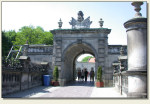
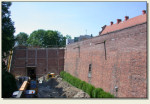
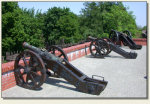
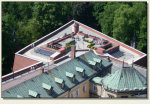
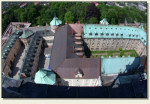
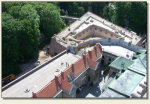

Nearest castles:
Polish castles - homepage
© 2009-2025 Bartosz Jastrzębski











